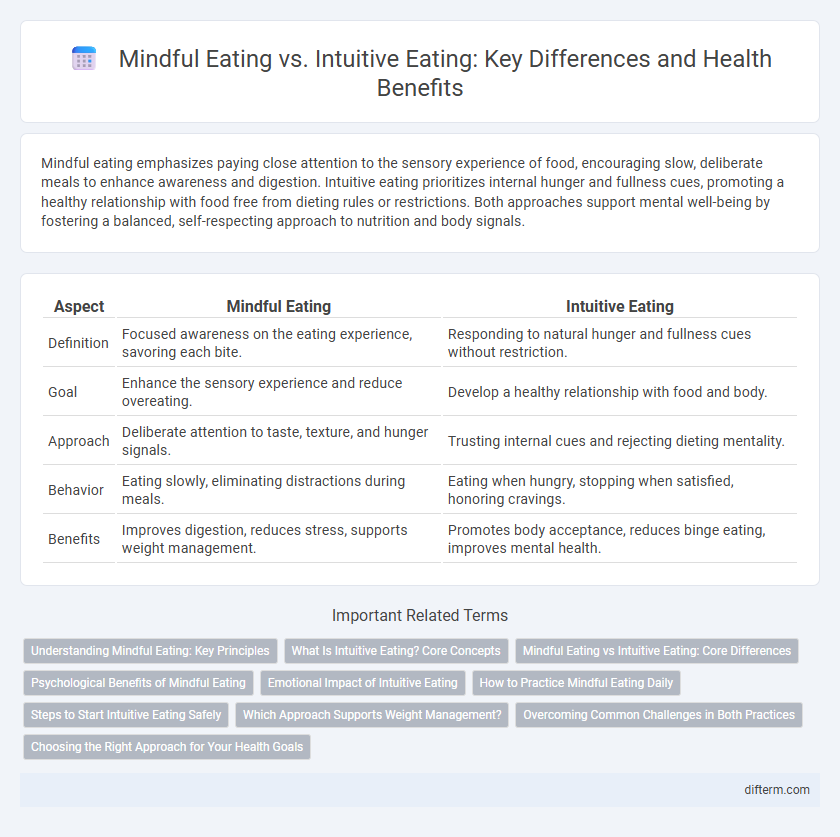Mindful eating emphasizes paying close attention to the sensory experience of food, encouraging slow, deliberate meals to enhance awareness and digestion. Intuitive eating prioritizes internal hunger and fullness cues, promoting a healthy relationship with food free from dieting rules or restrictions. Both approaches support mental well-being by fostering a balanced, self-respecting approach to nutrition and body signals.
Table of Comparison
| Aspect | Mindful Eating | Intuitive Eating |
|---|---|---|
| Definition | Focused awareness on the eating experience, savoring each bite. | Responding to natural hunger and fullness cues without restriction. |
| Goal | Enhance the sensory experience and reduce overeating. | Develop a healthy relationship with food and body. |
| Approach | Deliberate attention to taste, texture, and hunger signals. | Trusting internal cues and rejecting dieting mentality. |
| Behavior | Eating slowly, eliminating distractions during meals. | Eating when hungry, stopping when satisfied, honoring cravings. |
| Benefits | Improves digestion, reduces stress, supports weight management. | Promotes body acceptance, reduces binge eating, improves mental health. |
Understanding Mindful Eating: Key Principles
Mindful eating emphasizes paying full attention to the experience of eating, including the taste, texture, and aroma of food, as well as recognizing hunger and fullness cues without judgment. It encourages slowing down during meals, fostering awareness of emotional triggers and the body's nutritional needs, which can promote healthier eating habits and improved digestion. Practicing mindful eating can reduce overeating and increase satisfaction by cultivating a deeper connection between mind, body, and food choices.
What Is Intuitive Eating? Core Concepts
Intuitive eating is a nutritional philosophy centered on listening to the body's hunger and fullness signals rather than following external diet rules or restrictions. Core concepts include honoring hunger, respecting fullness, and making peace with food to promote a healthy relationship with eating and body image. This approach reduces stress around food choices and helps individuals develop self-trust in their eating habits.
Mindful Eating vs Intuitive Eating: Core Differences
Mindful eating emphasizes deliberate attention to the sensory experience of eating, focusing on taste, texture, and the body's hunger cues to foster control and reduce overeating. Intuitive eating encourages trusting the body's internal hunger and fullness signals without judgment, promoting a healthy relationship with food and rejecting diet mentality. Core differences lie in mindful eating's structured awareness practice versus intuitive eating's reliance on inherent bodily wisdom and emotional acceptance.
Psychological Benefits of Mindful Eating
Mindful eating enhances psychological well-being by promoting awareness of hunger and satiety cues, reducing emotional eating and stress-related binge episodes. This practice cultivates a non-judgmental attitude towards food, improving self-compassion and body image. Studies indicate mindful eating interventions can decrease anxiety and depression symptoms, fostering a healthier relationship with food and overall mental health.
Emotional Impact of Intuitive Eating
Intuitive eating significantly improves emotional well-being by fostering a positive relationship with food and reducing feelings of guilt or shame associated with eating. This approach encourages individuals to trust their body's hunger and fullness cues, which helps decrease stress and anxiety linked to restrictive dieting. Studies reveal that intuitive eaters experience enhanced self-esteem and lower rates of disordered eating behaviors compared to those practicing mindful eating.
How to Practice Mindful Eating Daily
Practicing mindful eating daily involves paying close attention to the sensory experience of each bite, including taste, texture, and aroma, while eliminating distractions such as screens or multitasking. Focusing on hunger and fullness cues helps regulate portion sizes and prevents overeating, promoting healthier digestion and weight management. Incorporating mindful pauses between bites encourages slower eating, enhancing digestion and satisfaction with meals.
Steps to Start Intuitive Eating Safely
Starting intuitive eating safely involves tuning into your body's hunger and fullness cues without judgment to restore a healthy relationship with food. Gradually allow all foods while discarding restrictive dieting rules, promoting self-compassion and trust in your body's signals. Consulting with a registered dietitian can provide personalized guidance to navigate emotional eating patterns and nutritional needs effectively.
Which Approach Supports Weight Management?
Mindful eating emphasizes paying close attention to hunger and fullness cues, promoting awareness of portion sizes and food choices, which can support sustainable weight management. Intuitive eating encourages listening to the body's natural signals without restriction or guilt, fostering a healthy relationship with food that may prevent overeating and emotional eating. Both approaches improve self-regulation and reduce binge eating, but mindful eating often provides more structured tools directly linked to weight control outcomes.
Overcoming Common Challenges in Both Practices
Mindful eating and intuitive eating both face challenges such as overcoming emotional eating triggers, managing food cravings, and breaking habitual overeating patterns. Developing awareness through consistent practice helps individuals recognize hunger and fullness cues, reducing impulsive food choices and promoting healthier relationships with food. Supportive strategies include journaling food experiences, practicing stress-reduction techniques, and seeking guidance from nutrition professionals to sustain progress.
Choosing the Right Approach for Your Health Goals
Mindful eating centers on increasing awareness of the sensory experience and hunger cues during meals, promoting deliberate food choices that enhance digestion and satisfaction. Intuitive eating encourages trusting the body's internal signals to guide eating habits, fostering a healthy relationship with food and reducing restrictive behaviors. Selecting between mindful and intuitive eating depends on individual health goals, such as weight management, emotional well-being, or addressing eating disorders, requiring personalized strategies for optimal outcomes.
Mindful Eating vs Intuitive Eating Infographic

 difterm.com
difterm.com